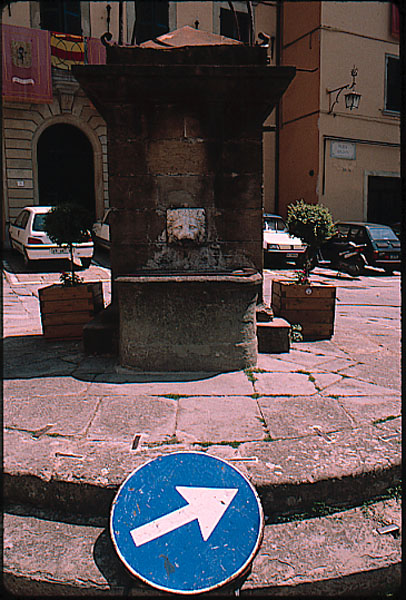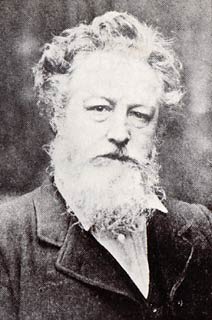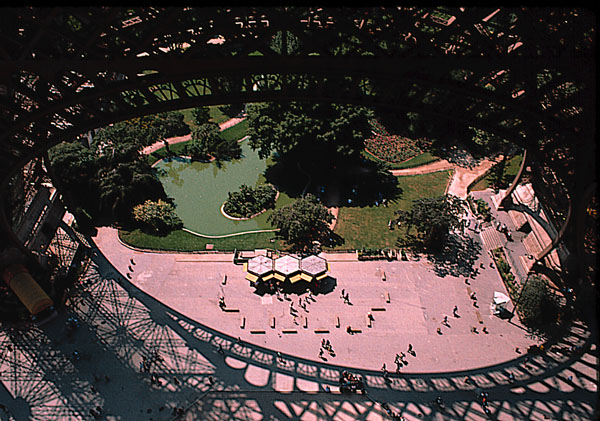
Ohio University Interior Architecture Program ARTI 350, Materials andConstruction I Fall 2011
Matthew Ziff, Associate Professor, Area Chair M. Arch, Architect, NCIDQ Office: W 325 Grover Center Office Hours: TTH: 11-3 Telephone: 740. 593. 2869 E-mail: ziff@ohio.edu

"Blue Arrow" photo by Matt Ziff
Course Content
This course is an exploration of the physical components of interior architecture.
"Never forget the material you are working with, and try always to use it for doing what it can do best: if you feel yourself hampered by the material in which you are working, instead of being helped by it, you have so far not learned your business, any more than a would-be poet has, who complains of the hardship of writing in measure and rhyme. The special limitations of the material should be a pleasure to you, not a hindrance..."
William Morris (famous British designer, writer, critic. 1834 - 1896)

"Architecture is the masterly, correct, and magnificent play of masses brought together in light. Our eyes are made to see forms in light; light and shade reveal these forms: cubes, cones, spheres, cylinders, or pyramids are the great primary forms."
Le Corbusier (famous Swiss architect, writer, painter. 1887 - 1965)

Course Structure
This course is designed for you to achieve: an understanding of basic structural systems and techniques used in constructing interior architecture an understanding of the characteristics of materials widely used in the construction and finishing of interior environments.
This course is placed in the interior architecture curriculum to support and enhance your design studio work. This course is primarily a lecture course, but two research projects that are directly related to the content of the course are also included. Materials and structures are studied to inform our design decisions, to enable us to interact with people in other design related fields, and to help us understand the physical qualities of the world in which we live.
Materials, and their architectural interior applications and uses will be presented within the context of building and designing situations. Discussions of materials will include historical examples of ways the material has been used in the past, the physical properties and characteristics of the material, manufacturing methods, and construction techniques concerning each material.
Please Note:
This course is primarily designed to support and to accompany the work undertaken in the Interior Architecture studio curriculum. If you are taking this course independent from the IA studio curriculum, you will not be at any disadvantage in this course, but you will not have the same relationship to the content as the studio IA majors. This is not a problem, it is simply a characteristic. Please do not worry about it, and please do not complain about it.

Course Required Readings
Page numbers refer to the text book, "Sustainable Building Systems and Construction for Designers" by Lisa M. Tucker.
week 1: general structural principles & principles of construction
week 2: floors:
week 3: walls:
week 4: ceilings:
week 5: doors and windows:
week 6: hvac, plumbing, electricity:
week 7: stairs and elevators:
week 8: cabinetry, millwork, moldings, veneers
week 9: building codes:
week 10: built-in furniture and equipment
Class Lectures
The following (in burgundy and underlined) are links to Power Point slide show versions of lectures given in class. This class schedule is a guide, (it is not 'cast in stone') and may be altered at the instructor's discretion.
Tuesday, September 6:
http://science.discovery.com/videos/how-its-made-swiss-army-knife-assembly.html How a Swiss Army knife is made.
http://science.discovery.com/videos/how-its-made-stainless-steel-flatware.html How stainless steel flatware is made.
Read pages 1 - 39 of "Sustainable Building Systems and Construction for Designers" (this will be called 'textbook' from now on)
Tuesday, September 13 & Thursday, September 15
http://www.youtube.com/watch?v=cY2rVKlbtV4 Installing wood bead board ceilings.
http://www.youtube.com/watch?v=jrBWCwtlUT4 Installing an Armstrong brand suspended ceiling.
Ceilings are described as being either:
1. tightly attached, or
2. suspended
These are basically the only options for installing a ceiling in a space; it is either attached to the underside of the structure above (which could be the underside of the floor above, or the underside of the structural pieces that support whatever is above them, (such as another floor, or the roof), like trusses, bar joists, or other types of structural elements, or the ceiling is suspended from whatever is above, again, such as the underside of structural pieces.
So, ceilings are able to be located anywhere from the highest available point in a space (like the underside of the floor structure above) down to the allowable code minimum lowest point in a space, which for human occupiable spaces is typically 7'-6" above the finished floor surface. Suspended ceilings always have some amount of space that is open (sometimes very little, sometimes very large) above the ceiling up to the structure above.
In some large buildings the amount of mechanical equipment is so great that an entire floor space is dedicated to this equipment. This kind of mechanical floor space is called an interstitial space. Hospitals frequently have this type of space because they have a tremendous amount of equipment that provides fluids, gases, and complex heating and cooling needs of a hospital.
The space above a suspended ceiling is called a plenum space, and is typically used as a space in which to run HVAC ductwork, springkler pipes, recessed lighting fixtures, electrical conduit, and other system components needed for a space.
The following are web sites of companies that manufacture ceiling systems. The sites include some good visual images of installed ceiling systems, and some good information about how these systems work.
http://www.bakermetal.com/CeilingSystems.htm
http://www.armstrong.com/commceilingsna/market_segment.jsp
http://www.armstrong.com/armstrong_home.jsp
http://www.novawall.com/
http://www.hunterdouglasceilings.com/
http://www.barrisolusa.com/gallery.html
http://www.barrisolusa.com/overview.html
Tuesday, September 20
http://www.videojug.com/film/how-to-build-a-brick-wall-2 How to build a brick wall.
NOTE: The chapters listed above (scroll up on this web page) are to be read as we cover the topics in class. For each exam I am going to include the information in each assigned book chapter.
Thursday, September 22
http://en.wikibooks.org/wiki/Adventist_Youth_Honors_Answer_Book/Vocational/Woodworking: An article about how wood is processed and about wood joint types.
http://grandpacliff.com/Science/Thinking.htm: Another article about wood and wood types.
http://www.youtube.com/watch?v=aJh8TK0Zhhw A short video showing a saw mill in operation.
http://www.youtube.com/watch?v=YTq4dLRCppQ&feature=related Another short video showing a small saw mill in operation.
"Sustainable Building Systems and Construction for Designers" Chapters 1 & 2
Lecture 6: Wood Framing & Stone
Tuesday, September 27:
map of the world:
http://www.privacyinternational.org/issues/foia/foia-laws.jpg
http://www.nature-worldwide.info/images/world_map.jpg
http://video.google.com/videoplay?docid=-3259199560118437356&vt=lf&hl=en
_______________________________________________________________________________
Thursday, September 29 : Exam 1
______________________________________________________________________________
EXAM 2 COVERS EVERYTHING FROM HERE DOWN TO THE DAY OF EXAM 2
Tuesday, October 4:
Lecture 6: Wood Framing & Stone
The following videos address Heavy Timber Framing and will be covered on Exam 2
http://www.youtube.com/watch?v=uBbpGVDm1t0
http://www.youtube.com/watch?v=0fxQDQlvt44&feature=related
http://www.youtube.com/watch?v=SN3nD_P-xP4&feature=related
http://www.youtube.com/watch?v=kPNzo6lTVg0&feature=related
http://www.youtube.com/watch?v=_YD466LcsNQ&feature=related
http://www.youtube.com/watch?v=t98Qt3bbD_A&feature=related
http://www.youtube.com/watch?v=UYtIFM1ek_M&feature=related Structures: The Arch
These two videos address ways poured concrete is placed, and how the framework for poured concrete is constructed, and will be coveed on Exam 2
http://www.youtube.com/watch?v=DVC4WkRoVPU&feature=related
Thursday, October 6:
Pages 41 - 79 of the Text Book contain much of the information about basic structural systems that I have presented over the past two weeks.
Read pages 182 - 219, Walls.
Matt's Writing Guidelines : to assist in writing the Material Manifesto paper.
Tuesday, October 11:
http://www.youtube.com/watch?v=PSurxsGQL90 Video showing how plate glass is made, using the 'float' process.
http://www.youtube.com/watch?v=ETJhw9_B_X4&feature=related Video about Dale Chihuly, glass artist.
http://www.dailymotion.com/video/x84m9b_chihuly-the-nature-of-glass_creation Video showing other Chihuly glass sculptures.
Thursday, October 13: Glass Continued
Tuesday, October 18: Glass Continued
These are two websites for companies that manufacture translucent concrete. No specific facts from these websites will be on Exam 2, but general awareness of translucent concrete, as I have discussed it in class, will be on the exam.
Translucent Concrete: http://www.lucem.de/index.php?id=8&L=1
Translucent Concrete: http://www.litracon.hu/index.php
Thursday, October 20:
Final set of Sketches From Observation DUE Today.
http://www.youtube.com/watch?v=KtT8yDTQesU Short video about wood doors.
Stile: A vertical piece in the frame of a paneled door or sash window
Rail: A horizontal piece in the frame of a paneled door or sash window
______________________________________________________________________
____________________________________________________________________________________
Tuesday, October 25: Exam 2: NOT open book & NOT open notes: you are going to have to commit to memory, the information addressed.
Bring sketchbooks to turn in to me, with each sketch assignment marked using a tab. I will grade them and then give you an opportunity to revise the sketches if you wish to do so.
__________________________________________________________________________________
Thursday, October 27:
Weather & Dew Point: http://www.youtube.com/watch?v=2J8-9MxlPgQ&feature=related
How A Refridgerator Works: http://www.youtube.com/watch?v=qrcEWhurQl4&feature=related
How Solar Panels Are Made: http://www.youtube.com/watch?v=RdnL5BSYj7s
Lecture 8: "Sustainable Building Systems and Construction for Designers" Chapter 7: Walls
Read pages 80 - 101, Mechanical Systems of the textbook.
http://www.youtube.com/watch?v=-ajqiPe_9Ko&feature=related Geothermal heating/cooling
http://www.youtube.com/watch?v=AprORaUFwiQ&feature=related Geothermal heating/cooling 2
http://www.youtube.com/watch?v=oc3qQ7PeqmA Solar Decathalon
http://www.youtube.com/watch?v=pdrvPeETHsY&feature=related Solar Decathalon II
http://www.youtube.com/watch?v=jTLSd6QcX7M Virginia Tech Solar Decathalon
Lecture 13: Building Codes, Fireplaces
Tuesday, November 1: Research Project #1 Due
Link to an explanatin of how a hydro-electric power plant makes electricity:
http://ga.water.usgs.gov/edu/hyhowworks.html
http://www.youtube.com/watch?v=cEL7yc8R42k hydro-electric power.
Lecture 14: Plumbing, Electricity, Stairs, Elevators
Thursday, November 3:
http://www.youtube.com/watch?v=mUMAfSBR4yg How electricity works.
Plumbing, Electricity, Stairs, Elevators: continued.
Read pages 162 - 180 of the textbook.
Tuesday, November 8
Elevators: continued.
http://www.youtube.com/watch?v=P7-PULbtlpU Spiral Staircases
http://science.discovery.com/videos/how-its-made-escalators.html How escalators are made
Thursday November 10: Last Day of Class: Research Project Boards Due Today
Research Project # 2 Due
Read pages 325 - 333 of the textbook.
Lecture 15: Escalators, Millwork, & Catalog Houses
http://www.youtube.com/watch?v=_uPy36IxoLY Sears Catalog Houses
Lecture 16: Built In Furniture & Straw Bale Construction
http://video.google.com/videoplay?docid=-5671284722381490874 Straw Bale Construction video
--------------------------------------------------------------------------------------------------------------------------------------------------------------------------------------------------------------------
Monday, November 21, 8:00am. Grover Center W 209.
The time listed is set by Ohio University and may not be changed. I am not allowed to change the time: do not ask me to do so.
A final exam or other 'summative experience' is required to be held for every course. A final exam may not be given on the last day of class.
----------------------------------------------------------------------------------------------------------------------------------------------------------------------------------------------------------------------
http://www.youtube.com/watch?v=PRPQYmd4ieQ Installing HVAC in a commercial building
http://science.discovery.com/videos/deconstructed-how-do-refrigerators-work.html How refrigerators work
http://www.youtube.com/watch?v=1MiQCBIx1mM How air conditioning works: a short explanation
http://www.youtube.com/watch?v=AmWrGPKcMNM How photo voltaic solar panels work.
http://www.youtube.com/watch?v=zEEOPjjh040&feature=related How photo voltaic solar panels work 2.
http://www.youtube.com/watch?v=ysDXwvNGHeM&feature=related Large scale solar power installations in the US
http://www.nrel.gov/data/pix/collections_zion.html Zion National Park Visitors Center
http://www.cleanskies.com/videos/new-intl-green-building-codes-launched The USBGC Announces Green Building Code Initiative
http://green.blogs.nytimes.com/2010/01/15/california-adopts-green-building-codes/ Article in the New York Times about Green building codes.
http://www.youtube.com/watch?v=tClGbvrj1kM News release about San Francisco's initiative toward green building codes.
http://www.fireengineering.com/index/articles/display/258039/articles/fire-engineering/volume-159/issue-6/features/the-dangers-of-lightweight-steel-construction.html A good article about the fire dangers involved in using light weight steel contruction.
http://video.google.com/videoplay?docid=-5671284722381490874
http://www.youtube.com/watch?v=LZABqaEsrLM
http://www.ecobroker.com/userdef/articles/Straw.Bale.Homes/StrawBaleHomeBasics.pdf A good PDF format document about straw bale construction.
"Brilliant Simplicity" http://vimeo.com/7415276 A video presenation about designers, innovation, and environment
Weights of Construction Materials Standards: Dimensions, Weights, Materials
Weights of Building Materials & Floor Loads for Buildings Standards: Dimensions, Weights, Materials
http://www.mcvicker.com/resguide/page011.htm Weight of Building Materials
How to Plaster a Wall http://www.youtube.com/watch?v=J9wpceIlxCU
How to Tile A Bathroom Wall http://www.youtube.com/watch?v=0FG3jGclR7Q
http://www.youtube.com/watch?v=WTF7_Z_G3d0&feature=related World's tallest building: height still to be determined, but close to 900 meters tall.
http://science.discovery.com/videos/how-its-made/ Video showing how aluminum foil is made.
http://www.youtube.com/watch?v=4VUBV08AdUc How metal cymbals are made.
http://mha-net.org/html/gallery.htm A website showing numerous fireplaces:
http://www.youtube.com/watch?v=gSRXHl9RbbU&feature=related A tour of Frank Lloyd Wright's 'Falling Water'.
http://www.youtube.com/watch?v=fNudnI5tzf8 Wind Power
http://www.youtube.com/watch?v=76Sdq6csrME&feature=related The Gateway National Monument: The Arch of St. Louis, 630 feet tall.
http://www.youtube.com/watch?v=fg3moEI9V5g How Car Windshields are made.
http://www.youtube.com/watch?v=pEd2Oni88uY How Glass Blocks are made.
http://www.youtube.com/watch?v=sJbPd1OlxjA&feature=related How Glass Blocks are installed.
http://www.youtube.com/watch?v=mgRFPpZGx8Y&feature=related Bicycle power electricty
http://www.youtube.com/watch?v=Q3Awp-3CxSU How lightning happens.
http://web1.audubon.org/video/player_leeds.html Video about the Audubon Society LEED certified office spaces.
http://www.veoh.com/browse/videos/category/travel/watch/v340197kgmXs2Tr The Bradbury Building in Los Angeles:
http://www.youtube.com/watch?v=4yOhfi4_gqw&feature=related Another Catalog House Video
http://www.youtube.com/watch?v=V8HnwLDz4HA&feature=related Craftsman Homes
http://tours.tourfactory.com/tours/tour.asp?home=agent-52665.pages.tourfactory.com&t=627706 Craftsman house for sale.
http://usahomeandgarden.com/architecture/sears-homes/sears-homes.html A Sears Roebuck web page describing the history of their catalog houses.
http://www.arts-crafts.com/archive/sears/ Web page of the Arts & Crafts Society with images of many Sears Roebuck Kit Homes.
http://science.howstuffworks.com/elevator.htm How Elevators Work: be sure to 'click' to the second, and third pages of this site.
http://www.howstuffworks.com/escalator.htm How Escalators Work: be sure to 'click' to the second and third pages of this site as well.
http://www.howstuffworks.com/framed.htm?parent=elevator.htm&url=http://www.otis.com The Otis Elevator Company
http://gizmodo.com/5013802/zaha-hadids-dubai-opera-house-design-makes Zaha Hadid's Dubai Opera House
http://video.google.com/videosearch?hl=en&rls=en&q=building%20green%20videos&um=1&ie=UTF-8&sa=N&tab=wv#q=rammed%20earth%20construction&hl=en&emb=0 Rammed Earth Construction
http://www.youtube.com/watch?v=z7cdsBRouws Rammed Earth Construction
 "Paris Sidewalks" by Matt Ziff
"Paris Sidewalks" by Matt Ziff
Structural Terms
it is important to have a clear and accurate understanding of commonly used structural terminology. the terms apply to all construction technology--from furniture design to parking garages.
force in mechanics, the physical quantity which, when it acts on a body, either causes it to change its state of motion [acceleration] or tends to deform it [elastic strain]. forces are vector quantities with direction as well as magnitude.
compression: the force which tends to shorten a structural member
tension: the force which tends to lengthen a structural member
shear: parallel forces acting in opposite directions
span: the distance between the supports of a structural member
simple beam: a beam resting on two supports
cantilever beam: a beam which projects from a single support
bending moment: the tendency of forces to cause rotation in different parts of a beam
Considerations
because structures enclose and determine the configurations of spaces, their design is of great importance to an interior designer.
some of the structural decisions which have great impact on interior space planning are:
the distances between support walls and/or columns
the ratio of openings to solids in exterior walls
the locations of openings in exterior walls
the amount of building volume consumed by structure
the interference of the structure with building systems, such as mechanical and electrical services
the amount of deflection in floor and ceiling surfaces
locations where the structure may be safely punctured for vertical mechanical, electrical, and plumbing risers
the character of the structural system as it is perceived and experienced from interior spaces
the flexibility of the structural system with regard to future changes in interior planning.
Floors
The presence of a floor seems like an uncomplicated, and natural occurrence, but the design of a floor offers possibilities of experience that can truly enhance an interior environment.
What can a floor be?
What is a floor?
how thick is a floor
how heavy is a floor
what shape is a floor
what material is a floor made out of
what color is a floor
what level of visual surface reflectivity does a floor have
what level Of sound absorption, transmission, reflectivity does a floor have
how much does a floor cost to build
how long will a floor last
will this floor hurt anyone
will this floor help anyone
is this floor beautiful
what can happen inside of a floor?
Floors exist in many different terms.
Floors can be viewed in legal terms.
Local building codes and the Americans with Disabilities Act (ADA) influence the performance standards of floors.
These legal requirements are directed toward insuring that floors provide two distinct types of experiences for occupants/users.
One, is a matter of societal equity; fairness of access to experiences is the driving principle of the ADA. Disabled persons are entitled to be able to experience whatever the rest of the public experiences in terms of basic access.
The second, is a matter of physical safety. The design and construction of the physical environment can be dangerous in very basic ways.
Floors that are slippery when wet, stairs that are not uniform within one continuous run, transitions from one flooring material to another adjacent flooring material can be a tripping hazard, and handrails that do not provide adequate protection or support against falling, can all be dangerous elements in the physical environment.
Floors can exist in visual terms. Colors, shapes, textures, patterns, and degrees of opacity or translucence can be aspects of what a floor brings to an interior.
A floor can also be a relatively neutral field against which other objects or qualities of space are played out.
Floors can exist in acoustical terms. Sound reflects, is absorbed, or is transmitted, and floors are often poorly designed and built to provide needed acoustical qualities.
Floors exist, always, in constructional terms. How is the floor built? What materials and methods are involved in constructing the floor? Does the construction of the floor have any relationship to the rest of the interior environment? Can a person perceive/figure out the relationship between the floor, and other elements in the interior?
Floors exist in thermal terms. The material used for a floor determines the thermal qualities of a floor.
Dense, heavy materials absorb, hold, and slowly release heat, or cold. Light, porous materials do not hold heat or cold, and quickly adjust to the temperature of whatever is in contact with them.
Passive solar design is largely concerned with the orientation and the material construction of floors, roofs, and walls.
Solar energy is utilized in built spaces through principles of 'solar design', in which the materials and orientation of walls and floors influence how a space or building gain or avoid gaining heat.
Solar design may include 'active' solar design elements, such as photovoltaic cells that transform the sun's light into electrical energy, and solar collectors that allow sunlight to warm a collector panel that contains either a liquid such as water, or an antifreeze, or a gas, such as air. There are numerous websites that present solar design. One is listed here:
http://www.thenaturalhome.com/passivesolar.html
Walls
The hard data, the facts of the matter, so to speak, are subservient to the design sensibility that is broght to bear on the creation of a wall.
The notion of a 'design sensibility' includes thinking about and developing coherent positions regarding use, cost, client needs and desires, material characteristics, and public impact, but designing, as the set of actions that result in a work being built, or manufactured, has to be directed by a designer's holistic, or gestalt, sense of how things should be.
There are traditions of building, rules of thumb, guiding principles, budget limits, and physical limits that influence or define what we design and build, but these do not outweigh the ultimate effect of the designer's sensibility.
A wall designed by Frank Lloyd Wright will look like a wall designed by Frank Lloyd Wright, regardless of the constraints placed upon him.
This may be interpreted as an 'ego centric' view of designing, but that is not quite it. A good designer has no choice but to act in accordance with his/her own thoughts, understandings, and points of view.
Of course the designer's views are always tempered by the needs and desires of users or clients, and by the knowledge and skill of consultants, fabricators.. Design is, usually, a public art.
We design things for people, and because of this we have to be attentive and sensitive to how our ideas impact people who use the spaces or places that we design.
What can a wall be?
What is a wall?
how thick is a wall
how heavy is a wall
how tall is a wall
what shape is a wall
what material is a wall made out of
what color is a wall
what level of surface reflectivity does a wall have
what level of sound absorption, transmission, reflectivity does a wall have
how much does a wall cost to build
how long will a wall last
will this wall hurt anyone
will this wall help anyone
is this wall beautiful
is this wall important to you, to me, to someone
What can happen in a wall?
Individual Materials and Their Characteristics
Wood:
Wood may be used to build very large buildings, and very small delicate objects. At the largest scale of wood construction there is the technology of glue laminated wood members. Glulam, as it is called in the industry, is the gluing together of many pieces of wood to form a much larger, stronger, and higher quality wood member than could be obtained from a single simple piece of woodl.
Glulam beams are typically used to span relatively long distances, such as 30 feet or more.
At a similar large size of construction is heavy timber framing. Heavy timber framing is shown in several of the websites listed below. This way of building a frame structure uses traditional joinery techniques, such as wood pins, mortise and tenons, and notches.
At a lighter and smaller scale of wood members is platform and balloon framing, which is the kind of construction used to build most houses in the United States. Platform framing uses 2x4 wood studs, typically spaced at 16inches on center, with a variety of other sizes of wood members, such as 1x4, 2x6, 2x8 and 2x10 to construct the other parts of a wood frame construction, such as floor joists, roof rafters, door and window jambs and headers, and the top and bottom plates of walls. All of these pieces are relatively light wood members that when put together create a reasonable strong and rigid frame, onto which the sheathing of the building will be attached.
At a still lighter and small scale of wood members is built in and moveable furniture, such as reception desks, cabinets and counter tops, and tables and chairs. These elements, when made of wood, are usually made from small sized linear pieces, and thin panel materials, such as plywoods, which may have an outer layer of hardwood, or other finished material.
At a still lighter scale of wood is wood moulding and trim. Mouldings and trim are an important element in wood construction, especially in interiors. Mouldings and trim are used to cover the rough edges of construction, to add visual order and interest, and to provide protection from wear. Baseboards, chair rails, crown moulding, and other applications of wood trim all add to the overall character of a space.
At a still lighter scale of wood is wood veneer. Wood veneer is a thin, typically 1/6" or a bit less, sheet of wood that has been sliced off of a solid log. Veneer is an economical way to bring the character of a wood to a large surface area. One log of a wood, such as a beautiful American Walnut, will yield many square feet of veneer, which may be glued to a substrate of particle board, and then installed as a finished wall panel.
Wood veneer can be produced from almost any type of wood, but the hardwoods tend to yield the richest looking veneers. The exotic rainforest hardwoods, such as Rosewood, Ebony, and Zebrawood, to name just a few, are fabulously beautiful woods, but are all in danger of becoming extinct. These kinds of trees take a very long time to grow to a usable size, sometimes more than a hundred years, and once they are cut down, it is unlikely that they will reappear in our lifetime.
There are, on the other hand, managed forests that companies like Weyerhauser, and Georgia Pacific, have planted in which evergreen trees like pines, firs, and spruces, (which are the kinds of wood that are used for typical light frame wood construction) are planted on a schedule that will yield usable lumber within twenty years. Evergreen trees grow at a rate that is fast enough for us to see several generations of trees grown in the same location.
The following websites contain information about wood and wood construction.
http://www.foxmaple.com/workshops.html
http://www.mainebarncompany.com/
http://www.apawood.org/level_b.cfm?content=prd_main
Web addresses for brick and stone
http://www.maconline.org/tech/materials/brick/brick.html
http://www.quickrete.com/diy/project_24.html
http://www.maconline.org/tech/construction/bwood/bwood.html
http://www.multiarc.com/english/index.htm
http://www.maconline.org/tech/materials/brick/brick.html
http://www.oldhouseweb.net/stories/Detailed/942.shtml#Step 1: Identify, retain, preserve
http://www.usbuildingproducts.com/architec2.htm
http://www.bhg.com/default.sph/home_imp.class?FNC=proj__Asub_list_html___103___65___MasonryWalls
http://www.vermontmarbleandgranite.com/ http://www.brazilgranite.com/granite.htm
Brick and Stone
Stone is used more as a surfacing material than as a construction/structure material.
Stone used to be used in large pieces, blocks, for making entire buildings, eg, the Parthenon.
Today stone is rarely, if ever, used to fully construct a building.
Typically stone, of various types, is used as a surfacing material, frequently with a highly finished surface.
Marbles, granites, limestone, and slate are some of the most widely used stones for surface finish materials.
Typically these stones are used in relatively thin pieces, usually no more than 3inches thick, and generally no more than an inch thick.
Small thin pieces of rigid material are called 'tiles' in architectural language. Tiles can be made of nearly any material, such as wood, metal, glass, stone, cork, clay, or plastics. Stone tiles range in size from the very small, such as 3/4", to relatively large, such as 24" x 24".
Materials that are larger than 24" square are typically called 'slabs' rather than tiles, in an effort to disginguish the large, heavy, and more unwieldly pieces from the small, easily handled ones.
Web addresses for concrete construction and products
http://www.distinctiveconcrete.com/photo_gallery.htm#Projects
http://www.wildstyleinc.com/
http://www.GreatBuildings.com/cgi-bin/gbi.cgi/Convent_of_La_Tourette.html/cid_2463890.gbi
http://www.GreatBuildings.com/cgi-bin/gbi.cgi/Notre_Dame_du_Haut.html/cid_2399158.gbi
http://www.GreatBuildings.com/buildings/Bateson_Building.html http://www.GreatBuildings.com/buildings/Casa_Mila.html
http://www.GreatBuildings.com/cgi-bin/gbi.cgi/Guggenheim_Museum.html/cid_2165673.gbi
http://www.GreatBuildings.com/buildings/Kimbell_Museum.html http://www.GreatBuildings.com/buildings/Lion_Gate.html
http://www.GreatBuildings.com/buildings/Watts_Towers.html
Glass
http://www.dupont.com/safetyglass/lgn/stories/0905.html
Stair Design: General Guidelines
* 2R + t = 24-25 inches
* no more than 3/16" variation between successive risers and treads
* residential stairs: minimum width = 36" maximum riser height = 8 1/4" minimum tread depth = 9" minimum headroom = 6'-8"
* non residential stairs: minimum width = 44" maximum riser height = 7" minimum tread depth = 11" minimum headroom = 6'-8"
* maximum of travel of 12' in vertical rise without a landing
* outdoor stairs, or monumental stairs do not have to adhere to the riser and tread requirements of egress stairs.
* width of exit stair is calculated in terms of 'exit units' which are 22" units, based on the idea that one person is 22" wide.
* to calculate the number and size of steps in a run of stairs:
identify the required height, from finished floor, to finished floor
divide this height by the approximate height of the riser of one step
since there can be no partial steps, round off any non-whole numbers and divide the rounded number into the height of the run of the stairs.
this number is the accurate size of one riser, to the nearest tenth of an inch.
plug the riser height into the 2R+T=24-25 formula to determine how long each tread needs to be
To describe an element like a stair, or even a wall, requires that the three primary dimensions of the physical existence of that element be presented. In simple terms, when designing a stair, you must:
draw an elevation view of the stair, a plan view of the stair, and a vertical section of the stair.
This way you can actually see what is going on in each of these dimensions. Often just a plan view, or just an elevation view does not adequately reveal the overall physical character of the piece you are designing.
This is a very important aspect of designing; do not forget this!!
Web sites with stair information
http://woodstairs.com/
http://www.arcways.com/
http://www.stairwaysinc.com/
http://www.dsnelson.com/gallery.htm